Strategic Analysis of Emirates Airlines: Financial and SWOT Analysis
VerifiedAdded on 2020/06/04
|17
|4637
|47
Report
AI Summary
This report provides a comprehensive strategic analysis of Emirates Airlines, examining its financial performance, market position, and sustainability initiatives. The analysis includes a review of key financial ratios such as Return on Equity (ROE) and Return on Assets (ROA), along with a SWOT (Strengths, Weaknesses, Opportunities, and Threats) and PEST (Political, Economic, Social, and Technological) analysis. The report also evaluates Emirates Airlines' strategies, including its sales network, market share, and competitive advantages within the global airline industry. Furthermore, it identifies potential challenges and offers recommendations for enhancing strategic management and achieving long-term objectives. The report concludes with an overview of the company's current standing and future prospects, making it a valuable resource for students studying strategic management and business development. This document is contributed by a student to be published on the website Desklib, which is a platform that provides all the necessary AI-based study tools for students.
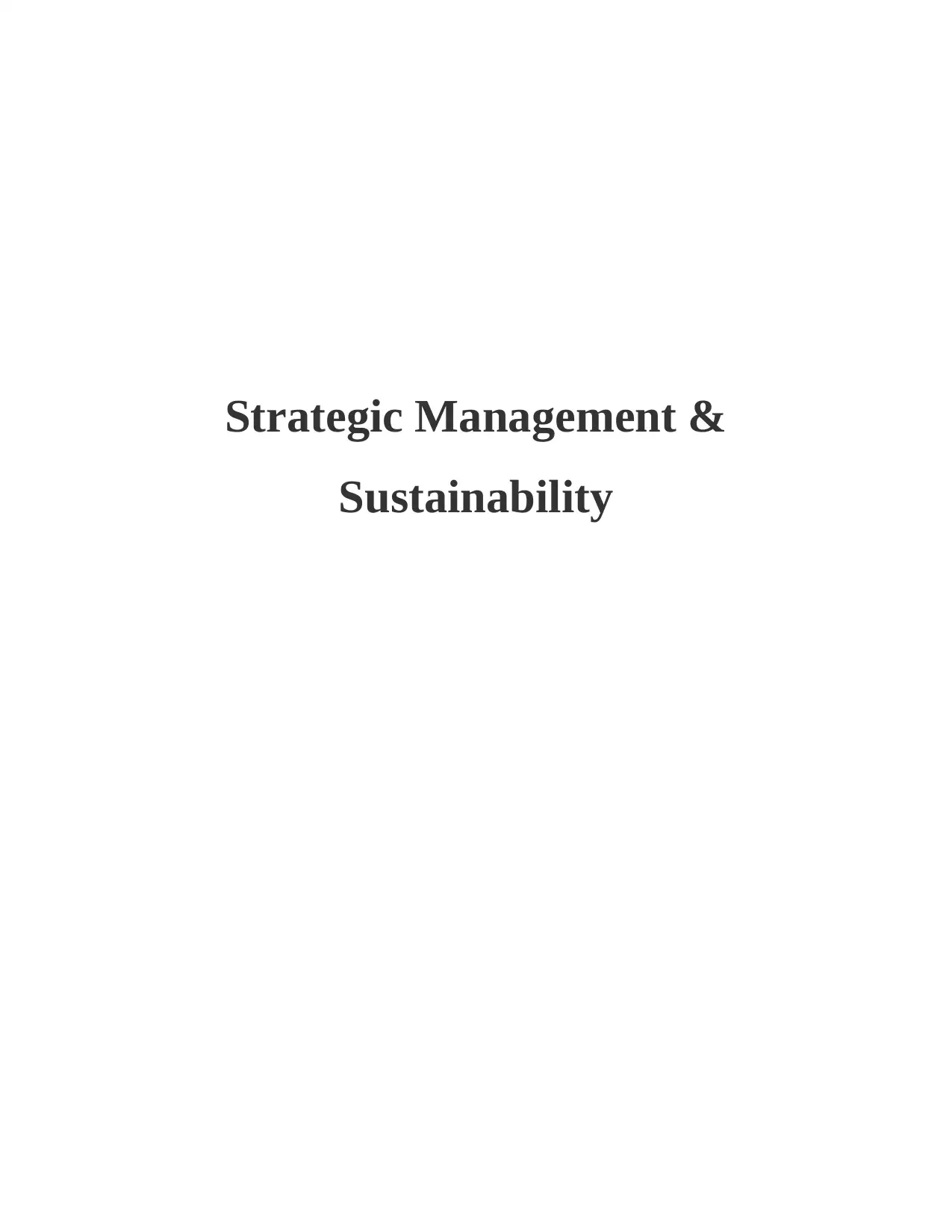
Strategic Management &
Sustainability
Sustainability
Paraphrase This Document
Need a fresh take? Get an instant paraphrase of this document with our AI Paraphraser
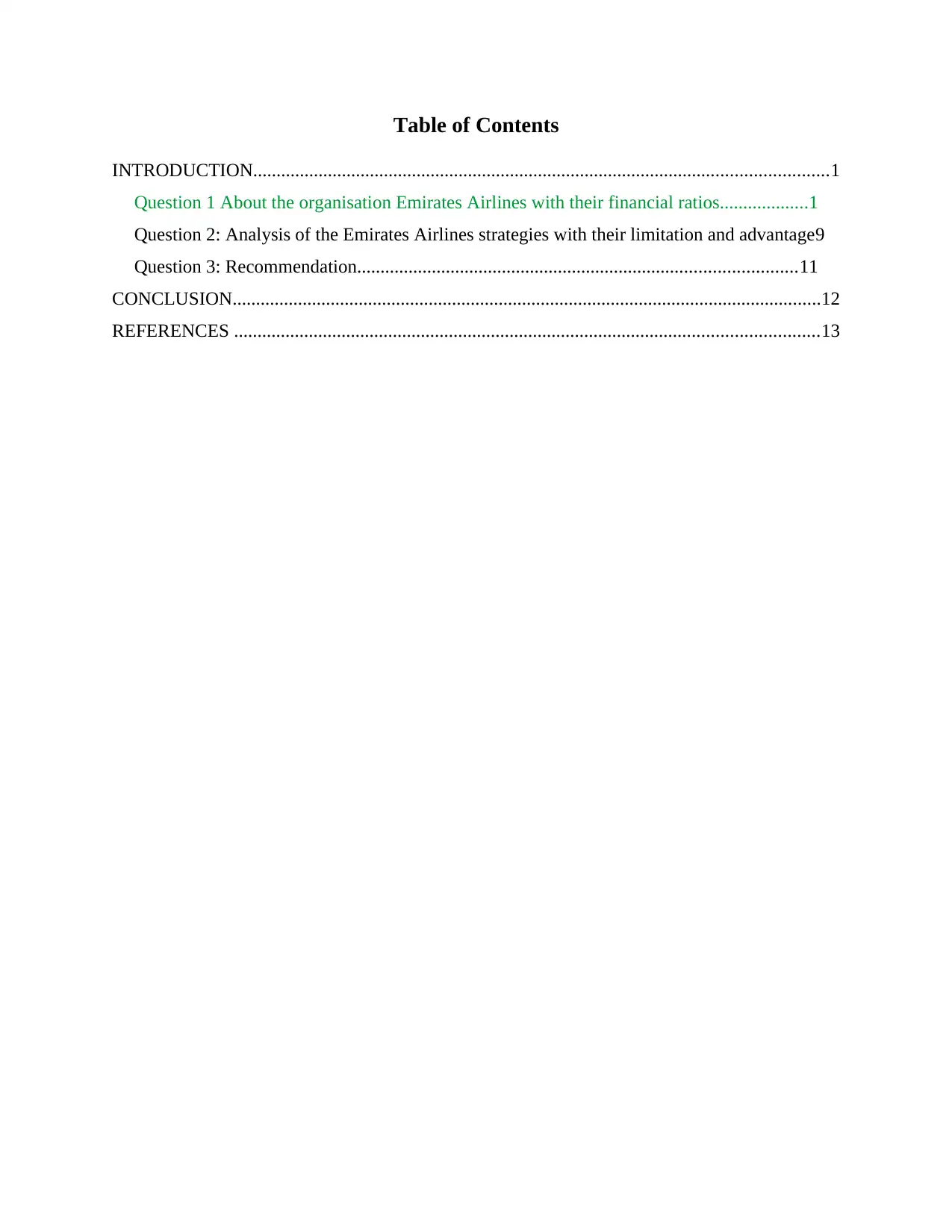
Table of Contents
INTRODUCTION...........................................................................................................................1
Question 1 About the organisation Emirates Airlines with their financial ratios...................1
Question 2: Analysis of the Emirates Airlines strategies with their limitation and advantage9
Question 3: Recommendation..............................................................................................11
CONCLUSION..............................................................................................................................12
REFERENCES .............................................................................................................................13
INTRODUCTION...........................................................................................................................1
Question 1 About the organisation Emirates Airlines with their financial ratios...................1
Question 2: Analysis of the Emirates Airlines strategies with their limitation and advantage9
Question 3: Recommendation..............................................................................................11
CONCLUSION..............................................................................................................................12
REFERENCES .............................................................................................................................13
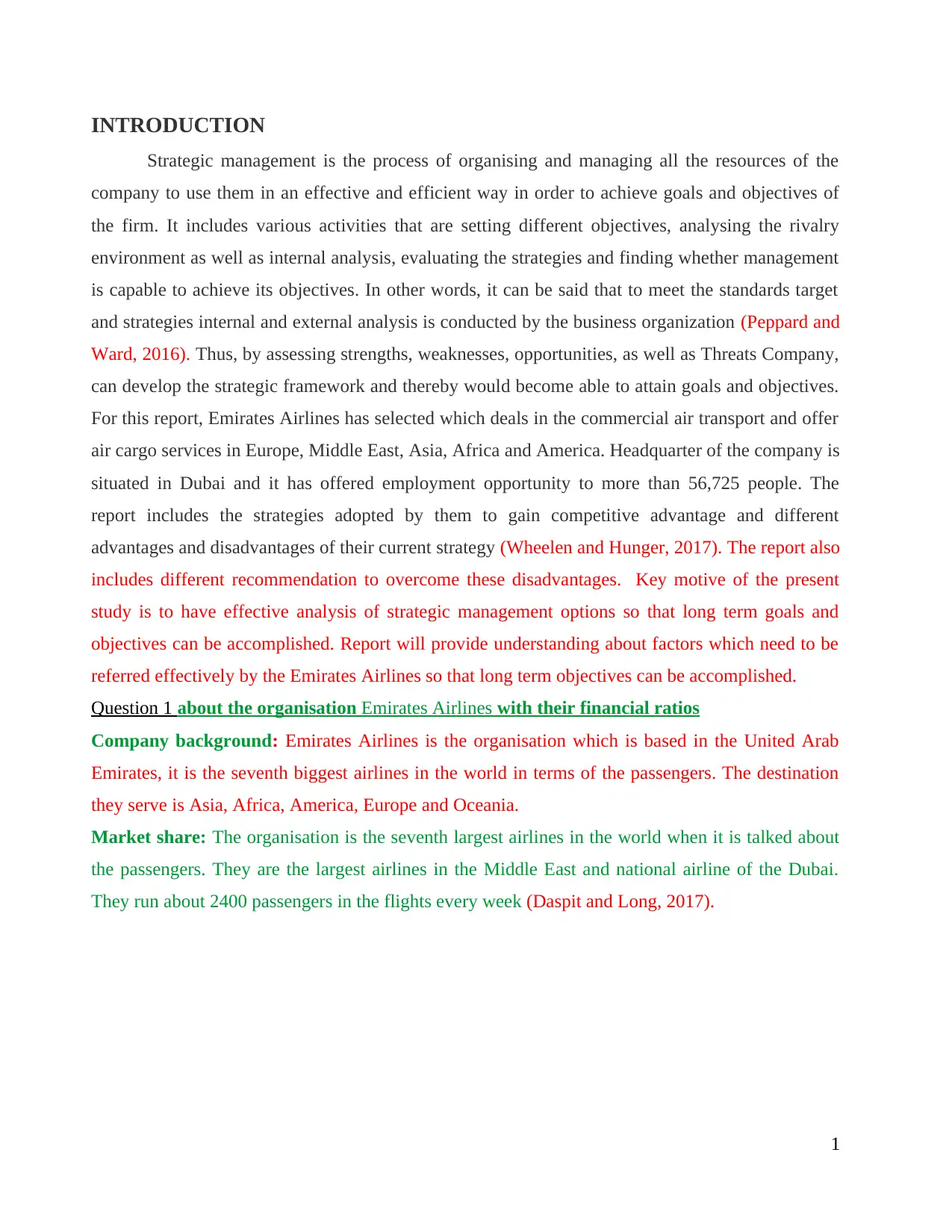
INTRODUCTION
Strategic management is the process of organising and managing all the resources of the
company to use them in an effective and efficient way in order to achieve goals and objectives of
the firm. It includes various activities that are setting different objectives, analysing the rivalry
environment as well as internal analysis, evaluating the strategies and finding whether management
is capable to achieve its objectives. In other words, it can be said that to meet the standards target
and strategies internal and external analysis is conducted by the business organization (Peppard and
Ward, 2016). Thus, by assessing strengths, weaknesses, opportunities, as well as Threats Company,
can develop the strategic framework and thereby would become able to attain goals and objectives.
For this report, Emirates Airlines has selected which deals in the commercial air transport and offer
air cargo services in Europe, Middle East, Asia, Africa and America. Headquarter of the company is
situated in Dubai and it has offered employment opportunity to more than 56,725 people. The
report includes the strategies adopted by them to gain competitive advantage and different
advantages and disadvantages of their current strategy (Wheelen and Hunger, 2017). The report also
includes different recommendation to overcome these disadvantages. Key motive of the present
study is to have effective analysis of strategic management options so that long term goals and
objectives can be accomplished. Report will provide understanding about factors which need to be
referred effectively by the Emirates Airlines so that long term objectives can be accomplished.
Question 1 about the organisation Emirates Airlines with their financial ratios
Company background: Emirates Airlines is the organisation which is based in the United Arab
Emirates, it is the seventh biggest airlines in the world in terms of the passengers. The destination
they serve is Asia, Africa, America, Europe and Oceania.
Market share: The organisation is the seventh largest airlines in the world when it is talked about
the passengers. They are the largest airlines in the Middle East and national airline of the Dubai.
They run about 2400 passengers in the flights every week (Daspit and Long, 2017).
1
Strategic management is the process of organising and managing all the resources of the
company to use them in an effective and efficient way in order to achieve goals and objectives of
the firm. It includes various activities that are setting different objectives, analysing the rivalry
environment as well as internal analysis, evaluating the strategies and finding whether management
is capable to achieve its objectives. In other words, it can be said that to meet the standards target
and strategies internal and external analysis is conducted by the business organization (Peppard and
Ward, 2016). Thus, by assessing strengths, weaknesses, opportunities, as well as Threats Company,
can develop the strategic framework and thereby would become able to attain goals and objectives.
For this report, Emirates Airlines has selected which deals in the commercial air transport and offer
air cargo services in Europe, Middle East, Asia, Africa and America. Headquarter of the company is
situated in Dubai and it has offered employment opportunity to more than 56,725 people. The
report includes the strategies adopted by them to gain competitive advantage and different
advantages and disadvantages of their current strategy (Wheelen and Hunger, 2017). The report also
includes different recommendation to overcome these disadvantages. Key motive of the present
study is to have effective analysis of strategic management options so that long term goals and
objectives can be accomplished. Report will provide understanding about factors which need to be
referred effectively by the Emirates Airlines so that long term objectives can be accomplished.
Question 1 about the organisation Emirates Airlines with their financial ratios
Company background: Emirates Airlines is the organisation which is based in the United Arab
Emirates, it is the seventh biggest airlines in the world in terms of the passengers. The destination
they serve is Asia, Africa, America, Europe and Oceania.
Market share: The organisation is the seventh largest airlines in the world when it is talked about
the passengers. They are the largest airlines in the Middle East and national airline of the Dubai.
They run about 2400 passengers in the flights every week (Daspit and Long, 2017).
1
⊘ This is a preview!⊘
Do you want full access?
Subscribe today to unlock all pages.

Trusted by 1+ million students worldwide
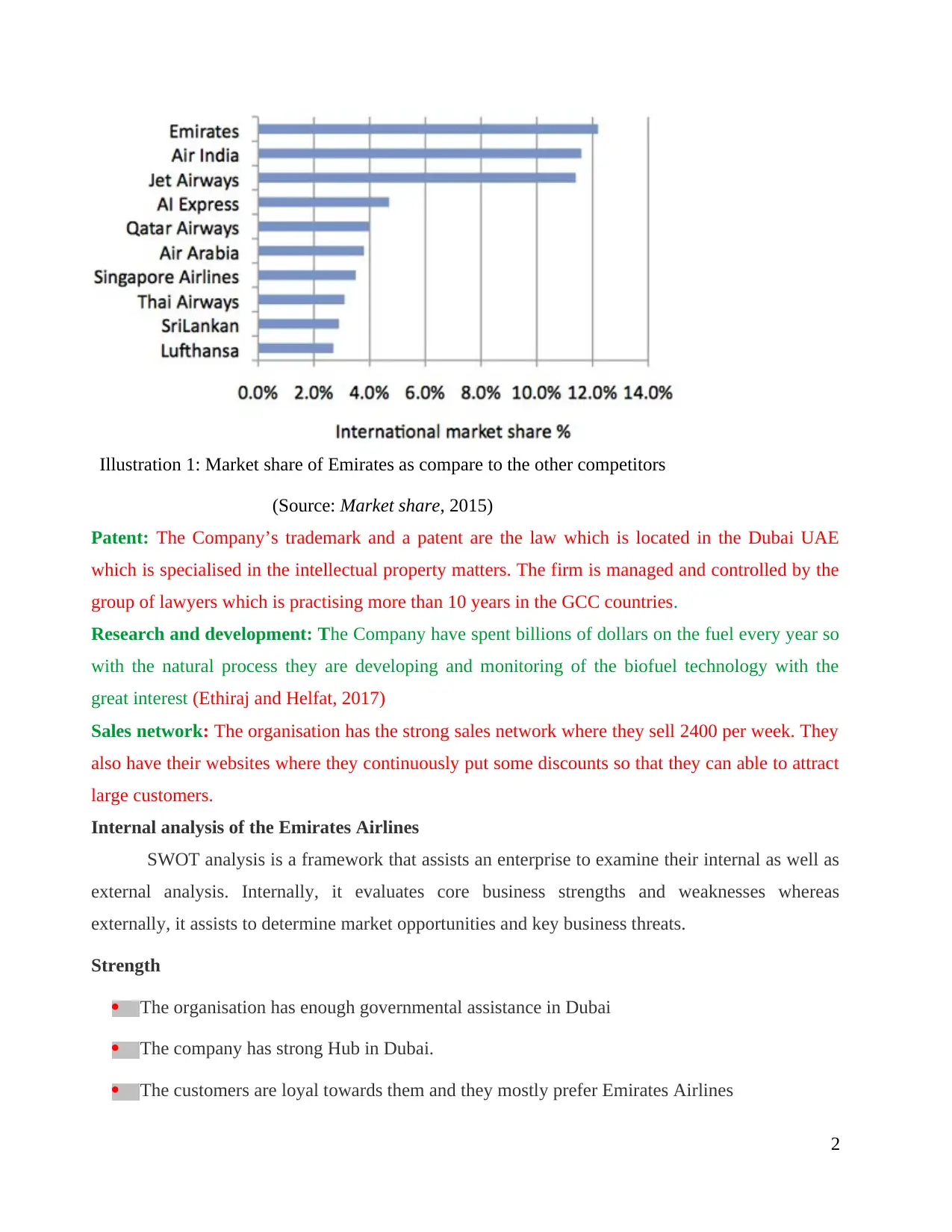
Illustration 1: Market share of Emirates as compare to the other competitors
(Source: Market share, 2015)
Patent: The Company’s trademark and a patent are the law which is located in the Dubai UAE
which is specialised in the intellectual property matters. The firm is managed and controlled by the
group of lawyers which is practising more than 10 years in the GCC countries.
Research and development: The Company have spent billions of dollars on the fuel every year so
with the natural process they are developing and monitoring of the biofuel technology with the
great interest (Ethiraj and Helfat, 2017)
Sales network: The organisation has the strong sales network where they sell 2400 per week. They
also have their websites where they continuously put some discounts so that they can able to attract
large customers.
Internal analysis of the Emirates Airlines
SWOT analysis is a framework that assists an enterprise to examine their internal as well as
external analysis. Internally, it evaluates core business strengths and weaknesses whereas
externally, it assists to determine market opportunities and key business threats.
Strength
The organisation has enough governmental assistance in Dubai
The company has strong Hub in Dubai.
The customers are loyal towards them and they mostly prefer Emirates Airlines
2
(Source: Market share, 2015)
Patent: The Company’s trademark and a patent are the law which is located in the Dubai UAE
which is specialised in the intellectual property matters. The firm is managed and controlled by the
group of lawyers which is practising more than 10 years in the GCC countries.
Research and development: The Company have spent billions of dollars on the fuel every year so
with the natural process they are developing and monitoring of the biofuel technology with the
great interest (Ethiraj and Helfat, 2017)
Sales network: The organisation has the strong sales network where they sell 2400 per week. They
also have their websites where they continuously put some discounts so that they can able to attract
large customers.
Internal analysis of the Emirates Airlines
SWOT analysis is a framework that assists an enterprise to examine their internal as well as
external analysis. Internally, it evaluates core business strengths and weaknesses whereas
externally, it assists to determine market opportunities and key business threats.
Strength
The organisation has enough governmental assistance in Dubai
The company has strong Hub in Dubai.
The customers are loyal towards them and they mostly prefer Emirates Airlines
2
Paraphrase This Document
Need a fresh take? Get an instant paraphrase of this document with our AI Paraphraser
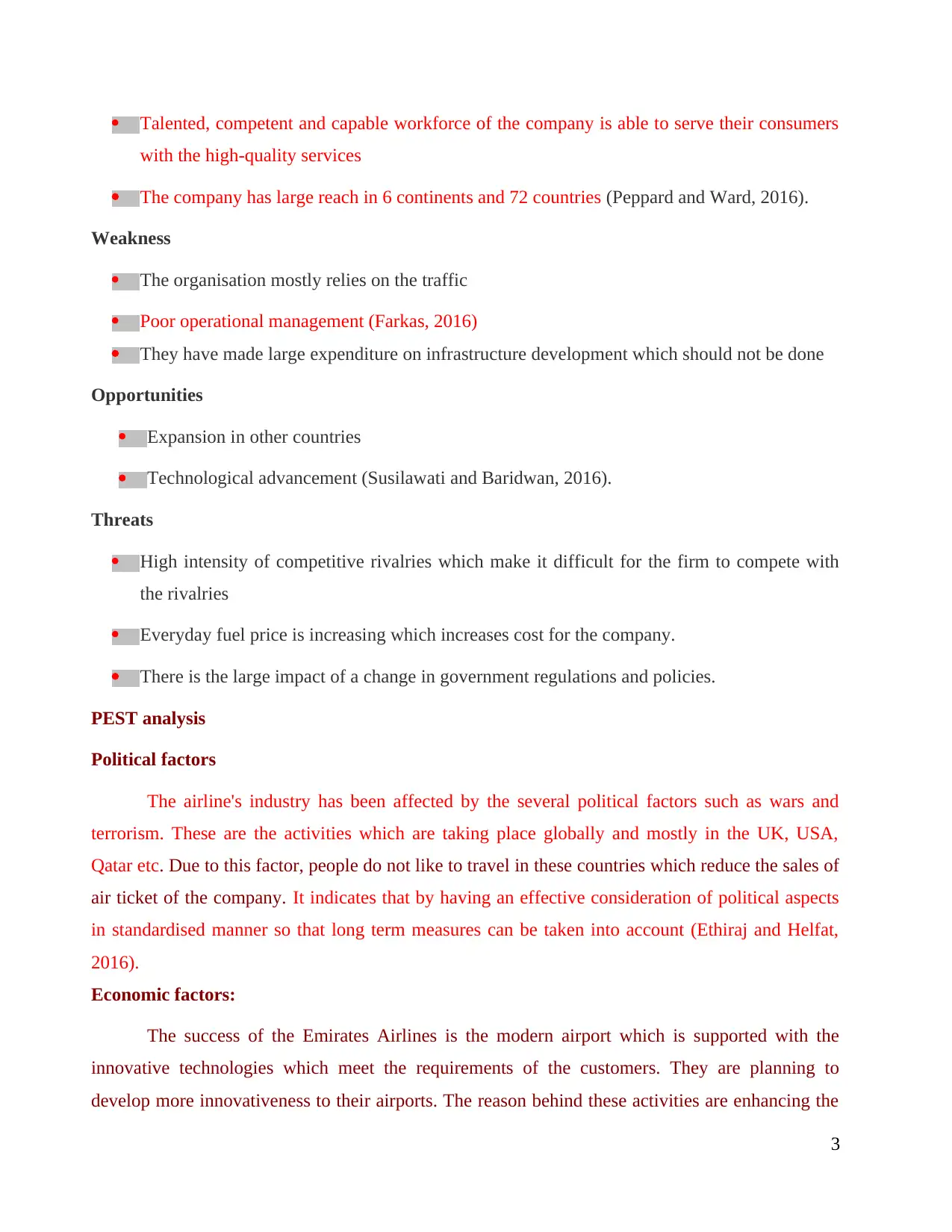
Talented, competent and capable workforce of the company is able to serve their consumers
with the high-quality services
The company has large reach in 6 continents and 72 countries (Peppard and Ward, 2016).
Weakness
The organisation mostly relies on the traffic
Poor operational management (Farkas, 2016)
They have made large expenditure on infrastructure development which should not be done
Opportunities
Expansion in other countries
Technological advancement (Susilawati and Baridwan, 2016).
Threats
High intensity of competitive rivalries which make it difficult for the firm to compete with
the rivalries
Everyday fuel price is increasing which increases cost for the company.
There is the large impact of a change in government regulations and policies.
PEST analysis
Political factors
The airline's industry has been affected by the several political factors such as wars and
terrorism. These are the activities which are taking place globally and mostly in the UK, USA,
Qatar etc. Due to this factor, people do not like to travel in these countries which reduce the sales of
air ticket of the company. It indicates that by having an effective consideration of political aspects
in standardised manner so that long term measures can be taken into account (Ethiraj and Helfat,
2016).
Economic factors:
The success of the Emirates Airlines is the modern airport which is supported with the
innovative technologies which meet the requirements of the customers. They are planning to
develop more innovativeness to their airports. The reason behind these activities are enhancing the
3
with the high-quality services
The company has large reach in 6 continents and 72 countries (Peppard and Ward, 2016).
Weakness
The organisation mostly relies on the traffic
Poor operational management (Farkas, 2016)
They have made large expenditure on infrastructure development which should not be done
Opportunities
Expansion in other countries
Technological advancement (Susilawati and Baridwan, 2016).
Threats
High intensity of competitive rivalries which make it difficult for the firm to compete with
the rivalries
Everyday fuel price is increasing which increases cost for the company.
There is the large impact of a change in government regulations and policies.
PEST analysis
Political factors
The airline's industry has been affected by the several political factors such as wars and
terrorism. These are the activities which are taking place globally and mostly in the UK, USA,
Qatar etc. Due to this factor, people do not like to travel in these countries which reduce the sales of
air ticket of the company. It indicates that by having an effective consideration of political aspects
in standardised manner so that long term measures can be taken into account (Ethiraj and Helfat,
2016).
Economic factors:
The success of the Emirates Airlines is the modern airport which is supported with the
innovative technologies which meet the requirements of the customers. They are planning to
develop more innovativeness to their airports. The reason behind these activities are enhancing the
3
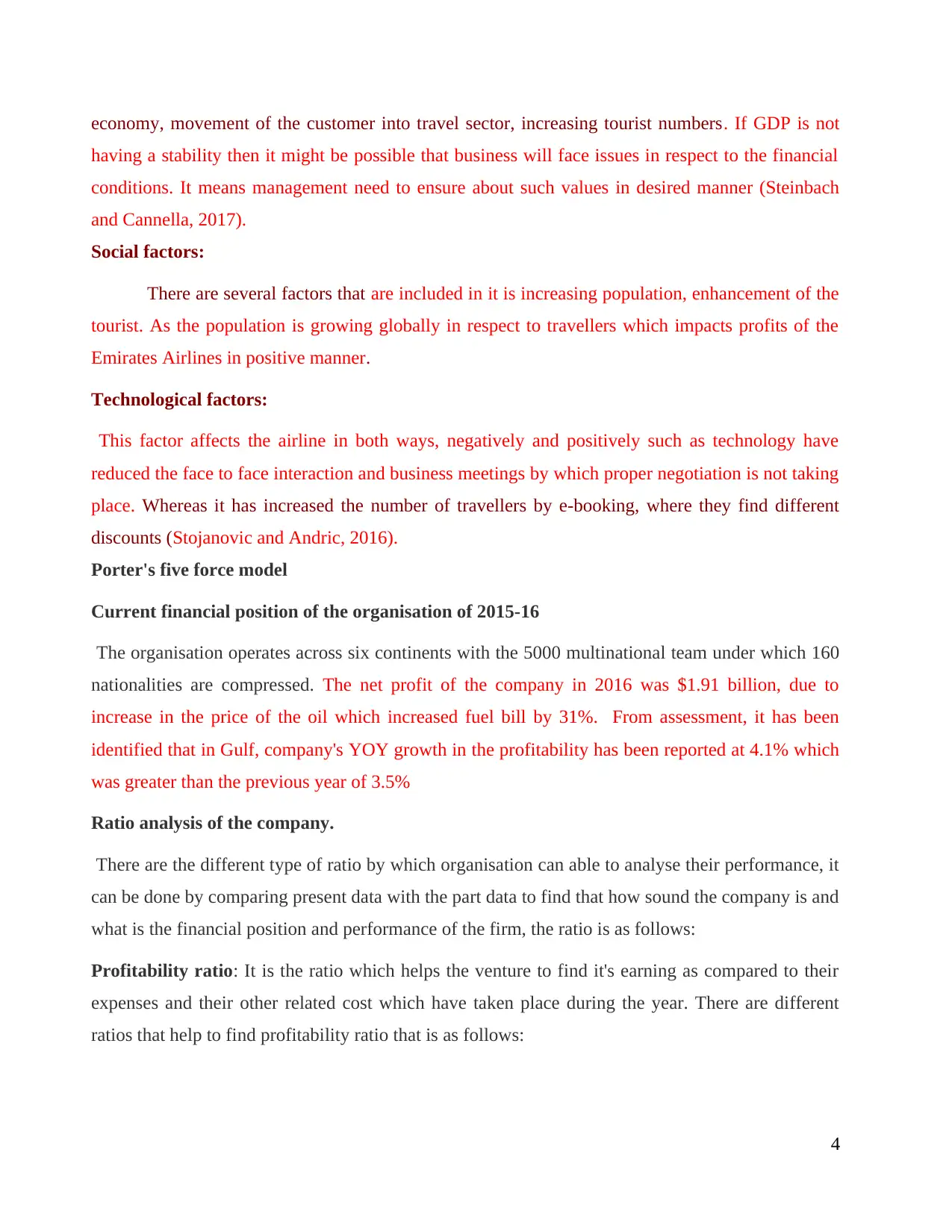
economy, movement of the customer into travel sector, increasing tourist numbers. If GDP is not
having a stability then it might be possible that business will face issues in respect to the financial
conditions. It means management need to ensure about such values in desired manner (Steinbach
and Cannella, 2017).
Social factors:
There are several factors that are included in it is increasing population, enhancement of the
tourist. As the population is growing globally in respect to travellers which impacts profits of the
Emirates Airlines in positive manner.
Technological factors:
This factor affects the airline in both ways, negatively and positively such as technology have
reduced the face to face interaction and business meetings by which proper negotiation is not taking
place. Whereas it has increased the number of travellers by e-booking, where they find different
discounts (Stojanovic and Andric, 2016).
Porter's five force model
Current financial position of the organisation of 2015-16
The organisation operates across six continents with the 5000 multinational team under which 160
nationalities are compressed. The net profit of the company in 2016 was $1.91 billion, due to
increase in the price of the oil which increased fuel bill by 31%. From assessment, it has been
identified that in Gulf, company's YOY growth in the profitability has been reported at 4.1% which
was greater than the previous year of 3.5%
Ratio analysis of the company.
There are the different type of ratio by which organisation can able to analyse their performance, it
can be done by comparing present data with the part data to find that how sound the company is and
what is the financial position and performance of the firm, the ratio is as follows:
Profitability ratio: It is the ratio which helps the venture to find it's earning as compared to their
expenses and their other related cost which have taken place during the year. There are different
ratios that help to find profitability ratio that is as follows:
4
having a stability then it might be possible that business will face issues in respect to the financial
conditions. It means management need to ensure about such values in desired manner (Steinbach
and Cannella, 2017).
Social factors:
There are several factors that are included in it is increasing population, enhancement of the
tourist. As the population is growing globally in respect to travellers which impacts profits of the
Emirates Airlines in positive manner.
Technological factors:
This factor affects the airline in both ways, negatively and positively such as technology have
reduced the face to face interaction and business meetings by which proper negotiation is not taking
place. Whereas it has increased the number of travellers by e-booking, where they find different
discounts (Stojanovic and Andric, 2016).
Porter's five force model
Current financial position of the organisation of 2015-16
The organisation operates across six continents with the 5000 multinational team under which 160
nationalities are compressed. The net profit of the company in 2016 was $1.91 billion, due to
increase in the price of the oil which increased fuel bill by 31%. From assessment, it has been
identified that in Gulf, company's YOY growth in the profitability has been reported at 4.1% which
was greater than the previous year of 3.5%
Ratio analysis of the company.
There are the different type of ratio by which organisation can able to analyse their performance, it
can be done by comparing present data with the part data to find that how sound the company is and
what is the financial position and performance of the firm, the ratio is as follows:
Profitability ratio: It is the ratio which helps the venture to find it's earning as compared to their
expenses and their other related cost which have taken place during the year. There are different
ratios that help to find profitability ratio that is as follows:
4
⊘ This is a preview!⊘
Do you want full access?
Subscribe today to unlock all pages.

Trusted by 1+ million students worldwide
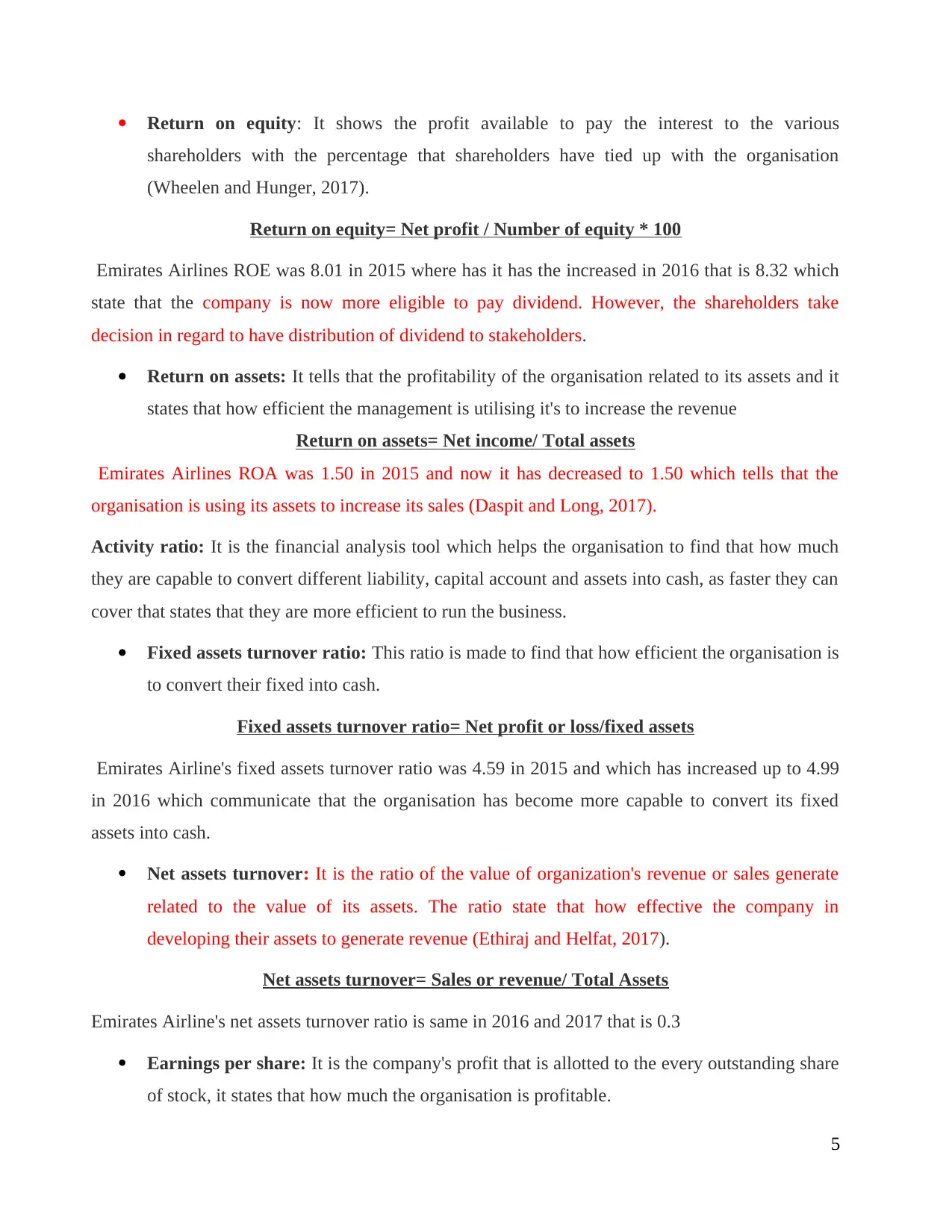
Return on equity: It shows the profit available to pay the interest to the various
shareholders with the percentage that shareholders have tied up with the organisation
(Wheelen and Hunger, 2017).
Return on equity= Net profit / Number of equity * 100
Emirates Airlines ROE was 8.01 in 2015 where has it has the increased in 2016 that is 8.32 which
state that the company is now more eligible to pay dividend. However, the shareholders take
decision in regard to have distribution of dividend to stakeholders.
Return on assets: It tells that the profitability of the organisation related to its assets and it
states that how efficient the management is utilising it's to increase the revenue
Return on assets= Net income/ Total assets
Emirates Airlines ROA was 1.50 in 2015 and now it has decreased to 1.50 which tells that the
organisation is using its assets to increase its sales (Daspit and Long, 2017).
Activity ratio: It is the financial analysis tool which helps the organisation to find that how much
they are capable to convert different liability, capital account and assets into cash, as faster they can
cover that states that they are more efficient to run the business.
Fixed assets turnover ratio: This ratio is made to find that how efficient the organisation is
to convert their fixed into cash.
Fixed assets turnover ratio= Net profit or loss/fixed assets
Emirates Airline's fixed assets turnover ratio was 4.59 in 2015 and which has increased up to 4.99
in 2016 which communicate that the organisation has become more capable to convert its fixed
assets into cash.
Net assets turnover: It is the ratio of the value of organization's revenue or sales generate
related to the value of its assets. The ratio state that how effective the company in
developing their assets to generate revenue (Ethiraj and Helfat, 2017).
Net assets turnover= Sales or revenue/ Total Assets
Emirates Airline's net assets turnover ratio is same in 2016 and 2017 that is 0.3
Earnings per share: It is the company's profit that is allotted to the every outstanding share
of stock, it states that how much the organisation is profitable.
5
shareholders with the percentage that shareholders have tied up with the organisation
(Wheelen and Hunger, 2017).
Return on equity= Net profit / Number of equity * 100
Emirates Airlines ROE was 8.01 in 2015 where has it has the increased in 2016 that is 8.32 which
state that the company is now more eligible to pay dividend. However, the shareholders take
decision in regard to have distribution of dividend to stakeholders.
Return on assets: It tells that the profitability of the organisation related to its assets and it
states that how efficient the management is utilising it's to increase the revenue
Return on assets= Net income/ Total assets
Emirates Airlines ROA was 1.50 in 2015 and now it has decreased to 1.50 which tells that the
organisation is using its assets to increase its sales (Daspit and Long, 2017).
Activity ratio: It is the financial analysis tool which helps the organisation to find that how much
they are capable to convert different liability, capital account and assets into cash, as faster they can
cover that states that they are more efficient to run the business.
Fixed assets turnover ratio: This ratio is made to find that how efficient the organisation is
to convert their fixed into cash.
Fixed assets turnover ratio= Net profit or loss/fixed assets
Emirates Airline's fixed assets turnover ratio was 4.59 in 2015 and which has increased up to 4.99
in 2016 which communicate that the organisation has become more capable to convert its fixed
assets into cash.
Net assets turnover: It is the ratio of the value of organization's revenue or sales generate
related to the value of its assets. The ratio state that how effective the company in
developing their assets to generate revenue (Ethiraj and Helfat, 2017).
Net assets turnover= Sales or revenue/ Total Assets
Emirates Airline's net assets turnover ratio is same in 2016 and 2017 that is 0.3
Earnings per share: It is the company's profit that is allotted to the every outstanding share
of stock, it states that how much the organisation is profitable.
5
Paraphrase This Document
Need a fresh take? Get an instant paraphrase of this document with our AI Paraphraser
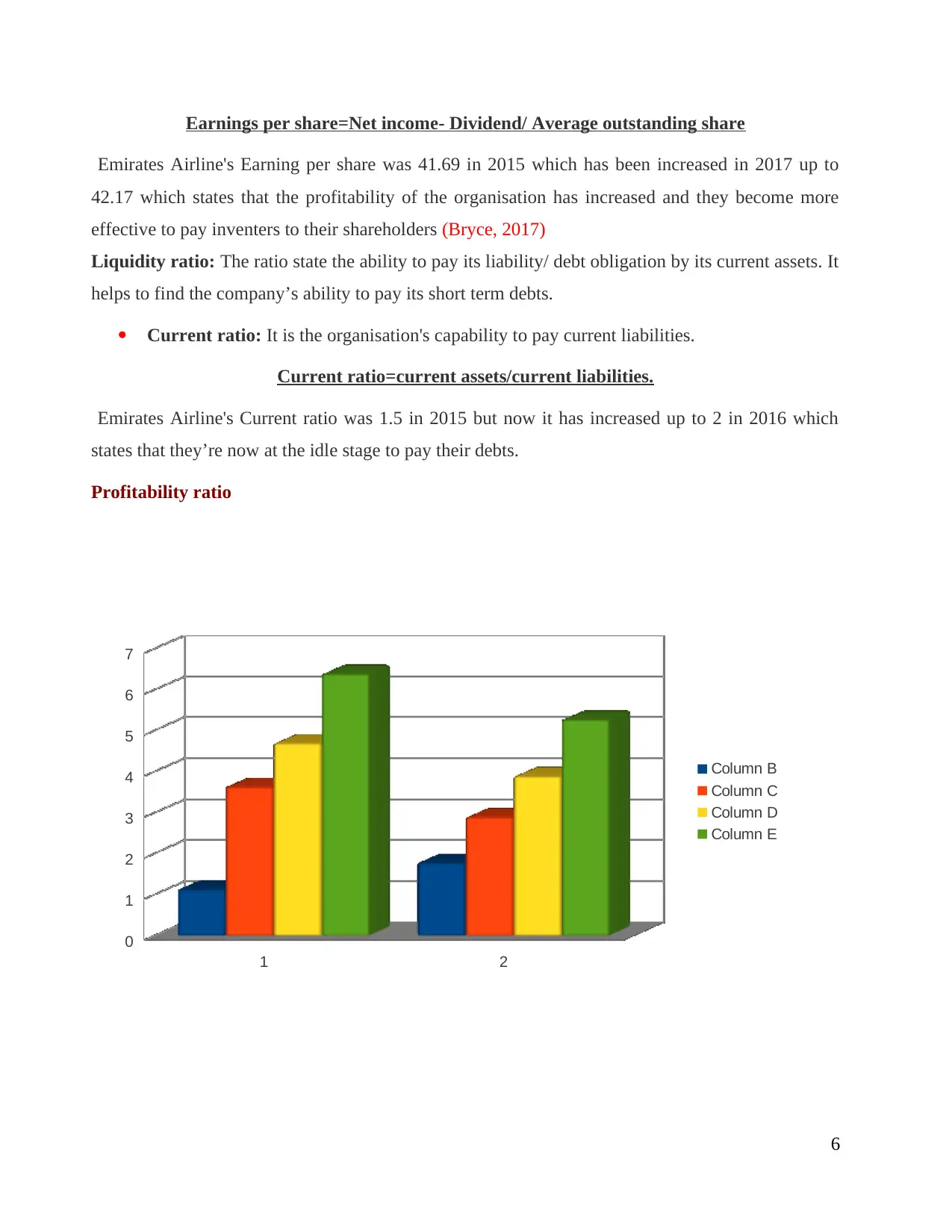
Earnings per share=Net income- Dividend/ Average outstanding share
Emirates Airline's Earning per share was 41.69 in 2015 which has been increased in 2017 up to
42.17 which states that the profitability of the organisation has increased and they become more
effective to pay inventers to their shareholders (Bryce, 2017)
Liquidity ratio: The ratio state the ability to pay its liability/ debt obligation by its current assets. It
helps to find the company’s ability to pay its short term debts.
Current ratio: It is the organisation's capability to pay current liabilities.
Current ratio=current assets/current liabilities.
Emirates Airline's Current ratio was 1.5 in 2015 but now it has increased up to 2 in 2016 which
states that they’re now at the idle stage to pay their debts.
Profitability ratio
1 2
0
1
2
3
4
5
6
7
Column B
Column C
Column D
Column E
6
Emirates Airline's Earning per share was 41.69 in 2015 which has been increased in 2017 up to
42.17 which states that the profitability of the organisation has increased and they become more
effective to pay inventers to their shareholders (Bryce, 2017)
Liquidity ratio: The ratio state the ability to pay its liability/ debt obligation by its current assets. It
helps to find the company’s ability to pay its short term debts.
Current ratio: It is the organisation's capability to pay current liabilities.
Current ratio=current assets/current liabilities.
Emirates Airline's Current ratio was 1.5 in 2015 but now it has increased up to 2 in 2016 which
states that they’re now at the idle stage to pay their debts.
Profitability ratio
1 2
0
1
2
3
4
5
6
7
Column B
Column C
Column D
Column E
6
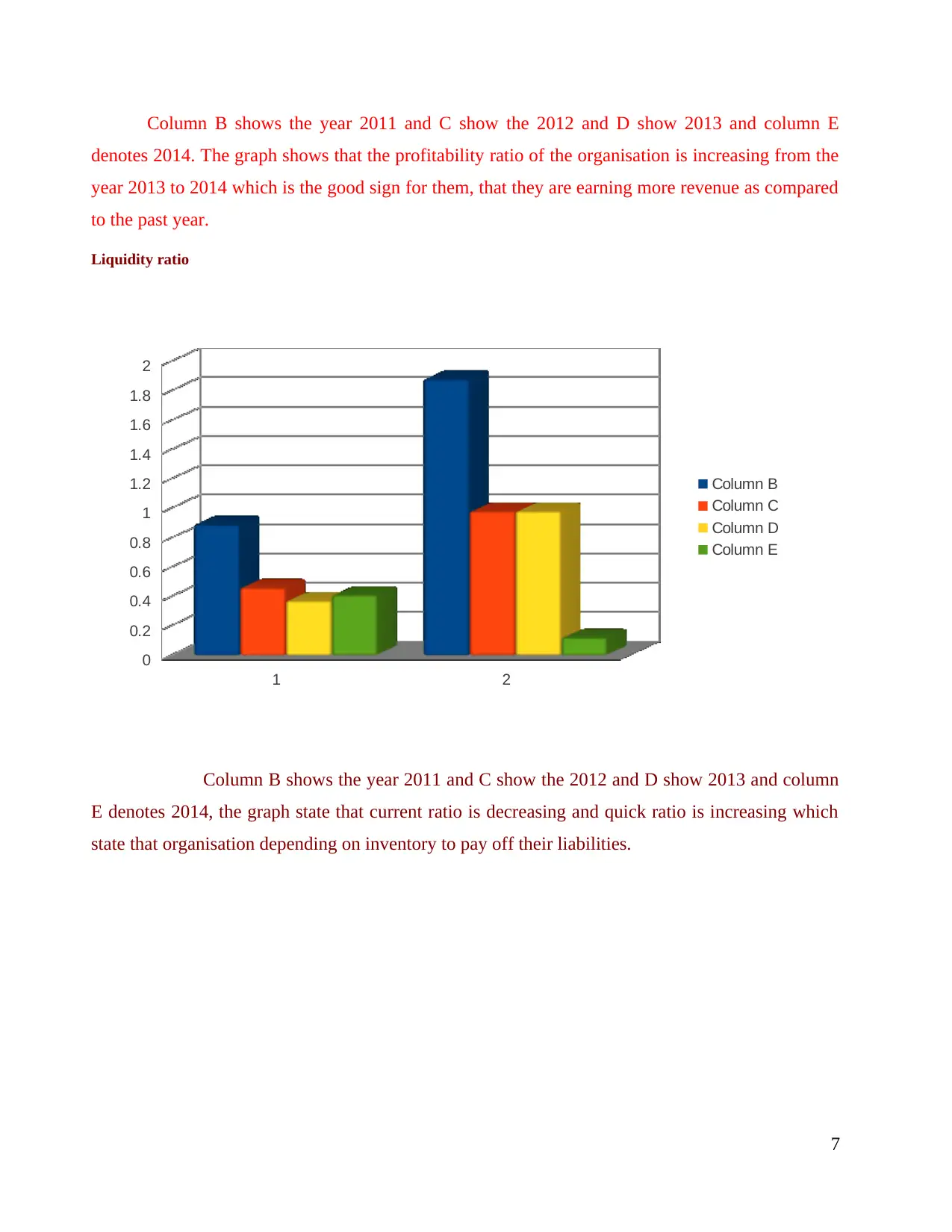
Column B shows the year 2011 and C show the 2012 and D show 2013 and column E
denotes 2014. The graph shows that the profitability ratio of the organisation is increasing from the
year 2013 to 2014 which is the good sign for them, that they are earning more revenue as compared
to the past year.
Liquidity ratio
1 2
0
0.2
0.4
0.6
0.8
1
1.2
1.4
1.6
1.8
2
Column B
Column C
Column D
Column E
Column B shows the year 2011 and C show the 2012 and D show 2013 and column
E denotes 2014, the graph state that current ratio is decreasing and quick ratio is increasing which
state that organisation depending on inventory to pay off their liabilities.
7
denotes 2014. The graph shows that the profitability ratio of the organisation is increasing from the
year 2013 to 2014 which is the good sign for them, that they are earning more revenue as compared
to the past year.
Liquidity ratio
1 2
0
0.2
0.4
0.6
0.8
1
1.2
1.4
1.6
1.8
2
Column B
Column C
Column D
Column E
Column B shows the year 2011 and C show the 2012 and D show 2013 and column
E denotes 2014, the graph state that current ratio is decreasing and quick ratio is increasing which
state that organisation depending on inventory to pay off their liabilities.
7
⊘ This is a preview!⊘
Do you want full access?
Subscribe today to unlock all pages.

Trusted by 1+ million students worldwide
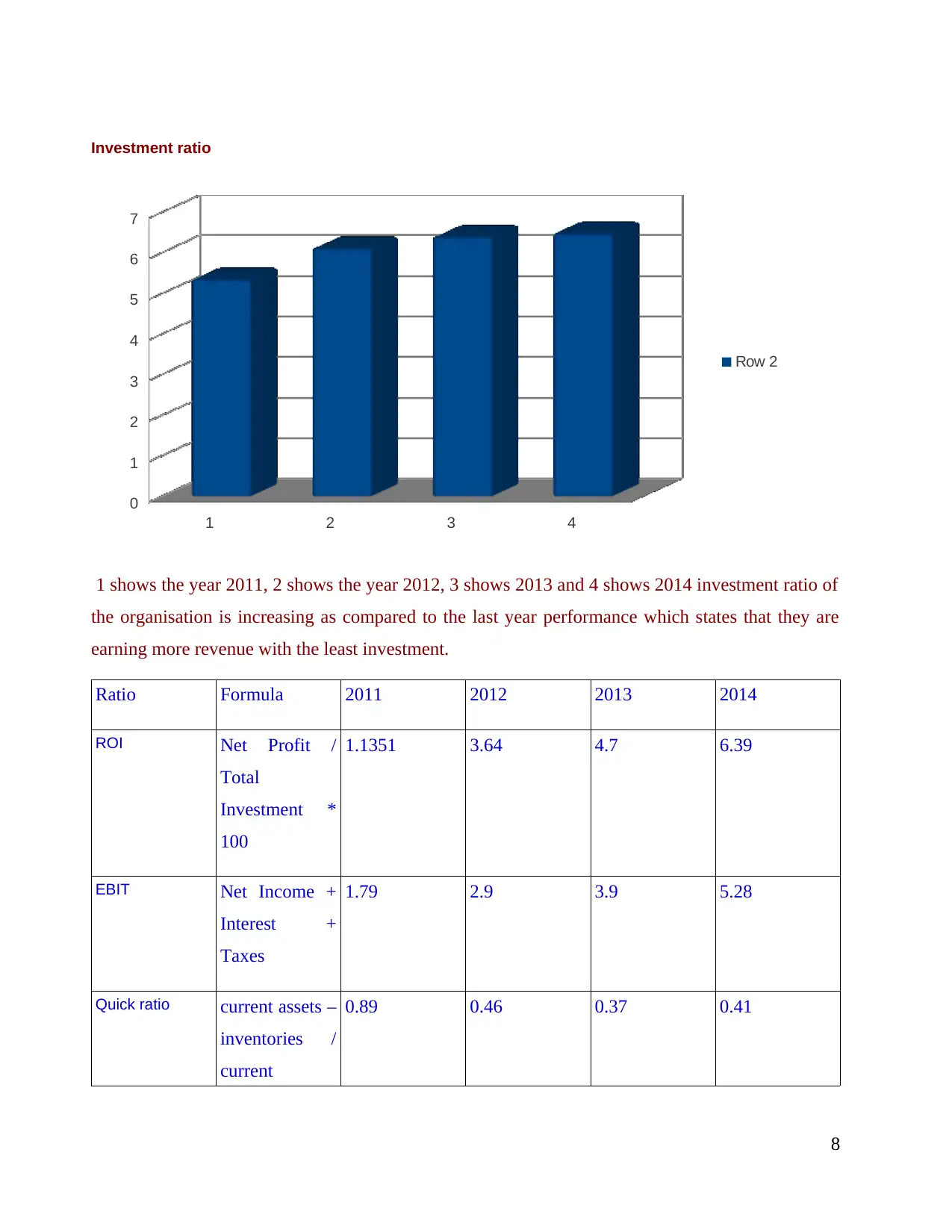
Investment ratio
1 2 3 4
0
1
2
3
4
5
6
7
Row 2
1 shows the year 2011, 2 shows the year 2012, 3 shows 2013 and 4 shows 2014 investment ratio of
the organisation is increasing as compared to the last year performance which states that they are
earning more revenue with the least investment.
Ratio Formula 2011 2012 2013 2014
ROI Net Profit /
Total
Investment *
100
1.1351 3.64 4.7 6.39
EBIT Net Income +
Interest +
Taxes
1.79 2.9 3.9 5.28
Quick ratio current assets –
inventories /
current
0.89 0.46 0.37 0.41
8
1 2 3 4
0
1
2
3
4
5
6
7
Row 2
1 shows the year 2011, 2 shows the year 2012, 3 shows 2013 and 4 shows 2014 investment ratio of
the organisation is increasing as compared to the last year performance which states that they are
earning more revenue with the least investment.
Ratio Formula 2011 2012 2013 2014
ROI Net Profit /
Total
Investment *
100
1.1351 3.64 4.7 6.39
EBIT Net Income +
Interest +
Taxes
1.79 2.9 3.9 5.28
Quick ratio current assets –
inventories /
current
0.89 0.46 0.37 0.41
8
Paraphrase This Document
Need a fresh take? Get an instant paraphrase of this document with our AI Paraphraser
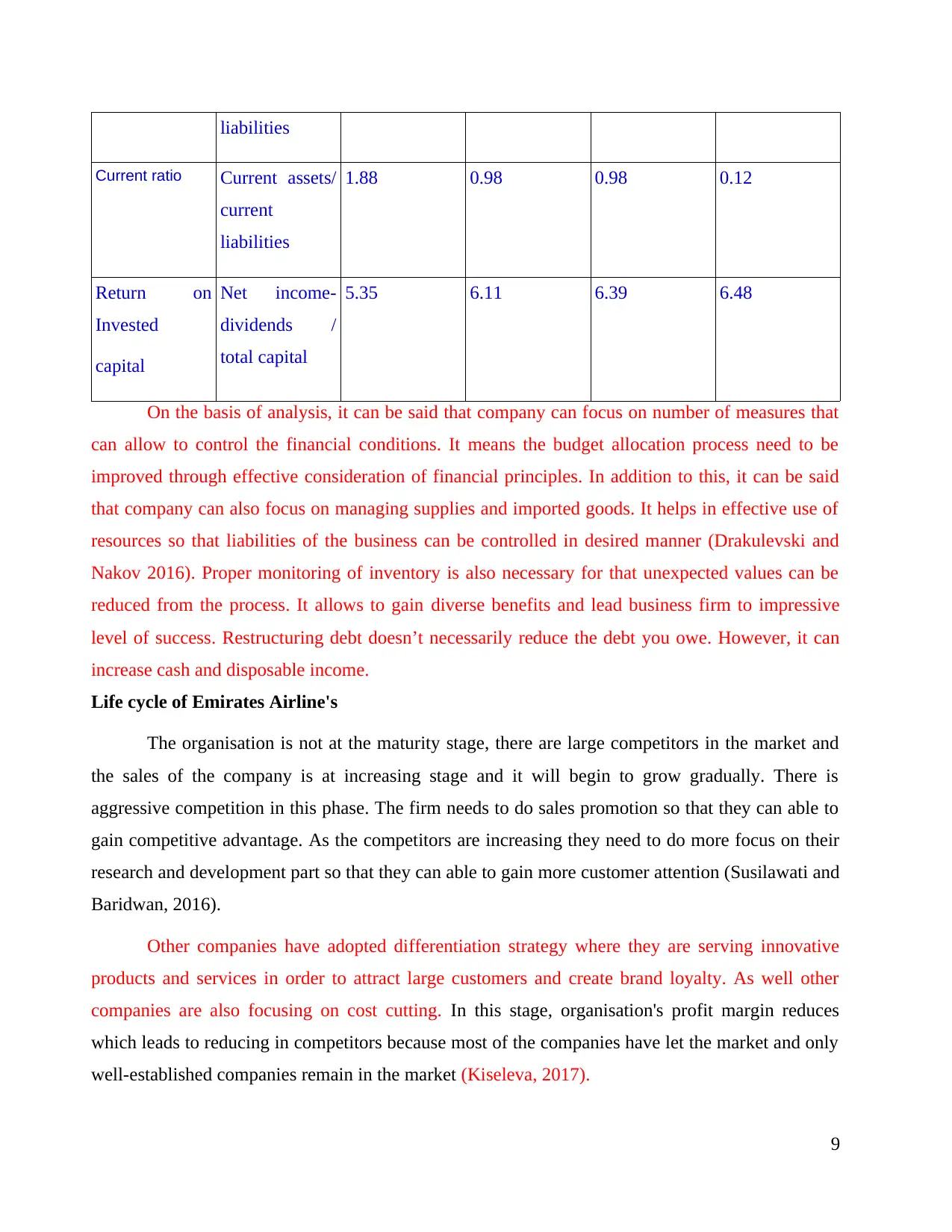
liabilities
Current ratio Current assets/
current
liabilities
1.88 0.98 0.98 0.12
Return on
Invested
capital
Net income-
dividends /
total capital
5.35 6.11 6.39 6.48
On the basis of analysis, it can be said that company can focus on number of measures that
can allow to control the financial conditions. It means the budget allocation process need to be
improved through effective consideration of financial principles. In addition to this, it can be said
that company can also focus on managing supplies and imported goods. It helps in effective use of
resources so that liabilities of the business can be controlled in desired manner (Drakulevski and
Nakov 2016). Proper monitoring of inventory is also necessary for that unexpected values can be
reduced from the process. It allows to gain diverse benefits and lead business firm to impressive
level of success. Restructuring debt doesn’t necessarily reduce the debt you owe. However, it can
increase cash and disposable income.
Life cycle of Emirates Airline's
The organisation is not at the maturity stage, there are large competitors in the market and
the sales of the company is at increasing stage and it will begin to grow gradually. There is
aggressive competition in this phase. The firm needs to do sales promotion so that they can able to
gain competitive advantage. As the competitors are increasing they need to do more focus on their
research and development part so that they can able to gain more customer attention (Susilawati and
Baridwan, 2016).
Other companies have adopted differentiation strategy where they are serving innovative
products and services in order to attract large customers and create brand loyalty. As well other
companies are also focusing on cost cutting. In this stage, organisation's profit margin reduces
which leads to reducing in competitors because most of the companies have let the market and only
well-established companies remain in the market (Kiseleva, 2017).
9
Current ratio Current assets/
current
liabilities
1.88 0.98 0.98 0.12
Return on
Invested
capital
Net income-
dividends /
total capital
5.35 6.11 6.39 6.48
On the basis of analysis, it can be said that company can focus on number of measures that
can allow to control the financial conditions. It means the budget allocation process need to be
improved through effective consideration of financial principles. In addition to this, it can be said
that company can also focus on managing supplies and imported goods. It helps in effective use of
resources so that liabilities of the business can be controlled in desired manner (Drakulevski and
Nakov 2016). Proper monitoring of inventory is also necessary for that unexpected values can be
reduced from the process. It allows to gain diverse benefits and lead business firm to impressive
level of success. Restructuring debt doesn’t necessarily reduce the debt you owe. However, it can
increase cash and disposable income.
Life cycle of Emirates Airline's
The organisation is not at the maturity stage, there are large competitors in the market and
the sales of the company is at increasing stage and it will begin to grow gradually. There is
aggressive competition in this phase. The firm needs to do sales promotion so that they can able to
gain competitive advantage. As the competitors are increasing they need to do more focus on their
research and development part so that they can able to gain more customer attention (Susilawati and
Baridwan, 2016).
Other companies have adopted differentiation strategy where they are serving innovative
products and services in order to attract large customers and create brand loyalty. As well other
companies are also focusing on cost cutting. In this stage, organisation's profit margin reduces
which leads to reducing in competitors because most of the companies have let the market and only
well-established companies remain in the market (Kiseleva, 2017).
9
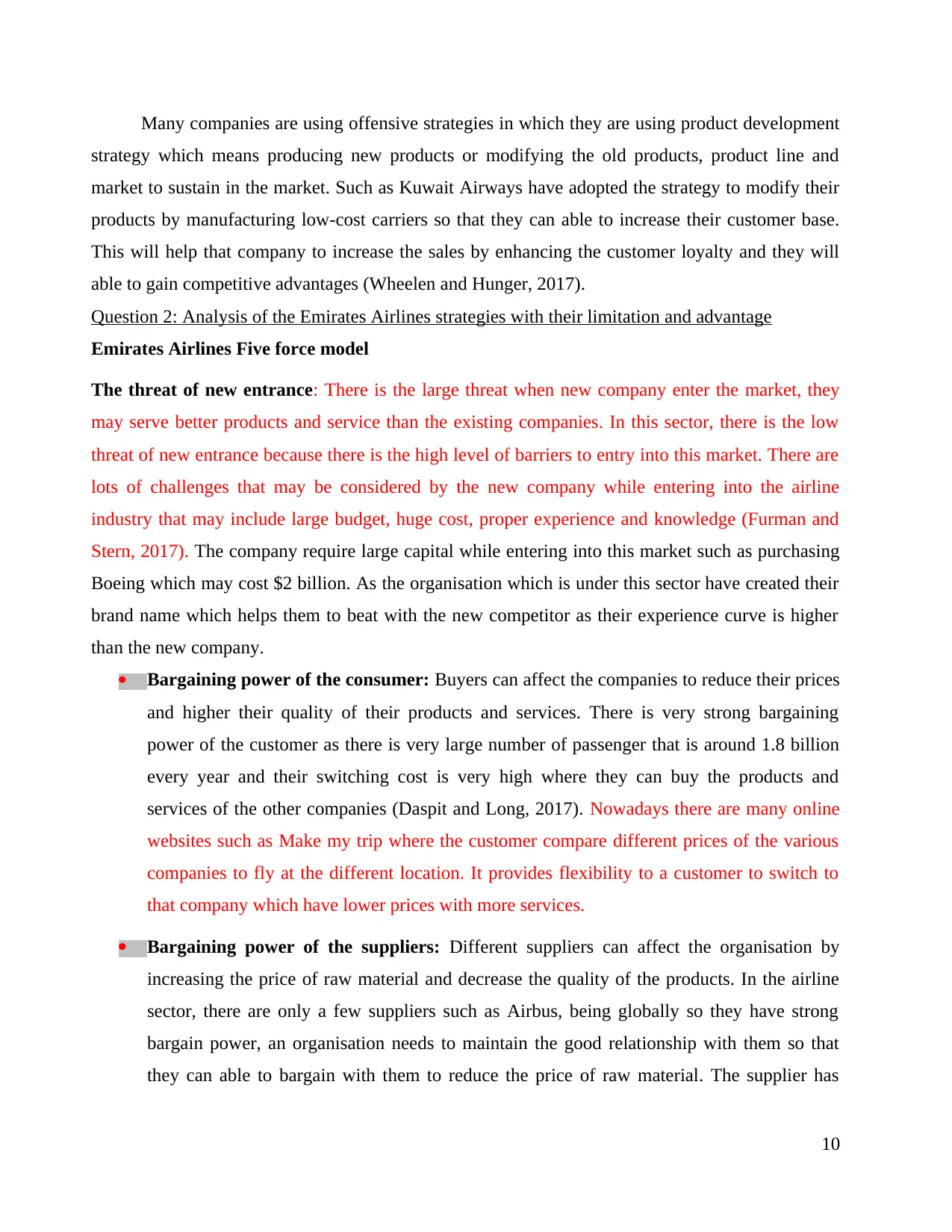
Many companies are using offensive strategies in which they are using product development
strategy which means producing new products or modifying the old products, product line and
market to sustain in the market. Such as Kuwait Airways have adopted the strategy to modify their
products by manufacturing low-cost carriers so that they can able to increase their customer base.
This will help that company to increase the sales by enhancing the customer loyalty and they will
able to gain competitive advantages (Wheelen and Hunger, 2017).
Question 2: Analysis of the Emirates Airlines strategies with their limitation and advantage
Emirates Airlines Five force model
The threat of new entrance: There is the large threat when new company enter the market, they
may serve better products and service than the existing companies. In this sector, there is the low
threat of new entrance because there is the high level of barriers to entry into this market. There are
lots of challenges that may be considered by the new company while entering into the airline
industry that may include large budget, huge cost, proper experience and knowledge (Furman and
Stern, 2017). The company require large capital while entering into this market such as purchasing
Boeing which may cost $2 billion. As the organisation which is under this sector have created their
brand name which helps them to beat with the new competitor as their experience curve is higher
than the new company.
Bargaining power of the consumer: Buyers can affect the companies to reduce their prices
and higher their quality of their products and services. There is very strong bargaining
power of the customer as there is very large number of passenger that is around 1.8 billion
every year and their switching cost is very high where they can buy the products and
services of the other companies (Daspit and Long, 2017). Nowadays there are many online
websites such as Make my trip where the customer compare different prices of the various
companies to fly at the different location. It provides flexibility to a customer to switch to
that company which have lower prices with more services.
Bargaining power of the suppliers: Different suppliers can affect the organisation by
increasing the price of raw material and decrease the quality of the products. In the airline
sector, there are only a few suppliers such as Airbus, being globally so they have strong
bargain power, an organisation needs to maintain the good relationship with them so that
they can able to bargain with them to reduce the price of raw material. The supplier has
10
strategy which means producing new products or modifying the old products, product line and
market to sustain in the market. Such as Kuwait Airways have adopted the strategy to modify their
products by manufacturing low-cost carriers so that they can able to increase their customer base.
This will help that company to increase the sales by enhancing the customer loyalty and they will
able to gain competitive advantages (Wheelen and Hunger, 2017).
Question 2: Analysis of the Emirates Airlines strategies with their limitation and advantage
Emirates Airlines Five force model
The threat of new entrance: There is the large threat when new company enter the market, they
may serve better products and service than the existing companies. In this sector, there is the low
threat of new entrance because there is the high level of barriers to entry into this market. There are
lots of challenges that may be considered by the new company while entering into the airline
industry that may include large budget, huge cost, proper experience and knowledge (Furman and
Stern, 2017). The company require large capital while entering into this market such as purchasing
Boeing which may cost $2 billion. As the organisation which is under this sector have created their
brand name which helps them to beat with the new competitor as their experience curve is higher
than the new company.
Bargaining power of the consumer: Buyers can affect the companies to reduce their prices
and higher their quality of their products and services. There is very strong bargaining
power of the customer as there is very large number of passenger that is around 1.8 billion
every year and their switching cost is very high where they can buy the products and
services of the other companies (Daspit and Long, 2017). Nowadays there are many online
websites such as Make my trip where the customer compare different prices of the various
companies to fly at the different location. It provides flexibility to a customer to switch to
that company which have lower prices with more services.
Bargaining power of the suppliers: Different suppliers can affect the organisation by
increasing the price of raw material and decrease the quality of the products. In the airline
sector, there are only a few suppliers such as Airbus, being globally so they have strong
bargain power, an organisation needs to maintain the good relationship with them so that
they can able to bargain with them to reduce the price of raw material. The supplier has
10
⊘ This is a preview!⊘
Do you want full access?
Subscribe today to unlock all pages.

Trusted by 1+ million students worldwide
1 out of 17
Related Documents
Your All-in-One AI-Powered Toolkit for Academic Success.
+13062052269
info@desklib.com
Available 24*7 on WhatsApp / Email
![[object Object]](/_next/static/media/star-bottom.7253800d.svg)
Unlock your academic potential
Copyright © 2020–2025 A2Z Services. All Rights Reserved. Developed and managed by ZUCOL.





